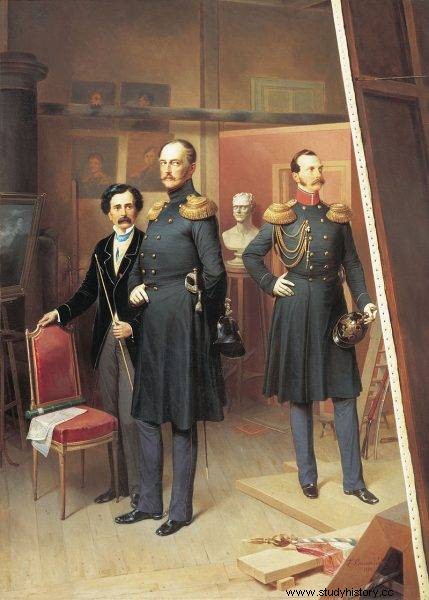On January 7 - according to the Julian calendar, which is 13 days behind the Gregorian calendar - Orthodox believers celebrate Christmas. The liturgy of St. Basil the Great, there are decorated Christmas trees in the houses. This custom appeared in Russia only 200 years ago. And it all started with ... the tsarist court!
The custom of decorating trees came to Russia from Germany. The first Christmas tree appeared on Christmas 1817 in the Kremlin Palace, where Grand Duchess Alexandra Feodorovna and her husband, the future Tsar Nicholas I, stayed at that time. Interestingly, in tsarist times Christmas was celebrated according to the Gregorian calendar.
Alexandra Feodorovna was the daughter of Frederick William III of Prussia. She decided to decorate the tree, transferring this tradition from her native Prussia, where it already existed in early Christian times. It was owed to the apostle of Germany - St. Boniface,
He was a missionary; he told the Gentiles about Jesus and the miracles he had performed. To prove the powerlessness of the pagan deities, he cut down a huge oak dedicated to Thor, the lord of storms and thunder. The tree fell down and knocked down several others. Only the fir tree survived, which Bonifacy called "the tree of the newborn Christ" .
Soon, fir trees began to appear in German homes for Christmas, although they were not initially decorated, as beautiful and fragrant conifers were considered sufficient decoration. Decorating Christmas trees only began during the Reformation.
A gift for everyone
The custom of decorating the tree quickly settled in the tsarist family. The Christmas tree was dressed on Christmas Eve, after the liturgy - an all-night vigil starting at approx. 17-18. Courtiers were also invited to the ceremony. In fact, each child of Nicholas I and Aleksandra Fedorovna (as well as tsarist nephews and nieces) had their own Christmas tree!
Of course, gifts were prepared; Nicholas I personally visited shops and chose gifts for the youngest - sweets, toys, books, clothes. Boys very often received gifts that were associated with the military:soldiers, sabers, uniforms. Olga, one of the tsar's daughters, even got her dream piano. The packages were not placed under the Christmas tree, but on special tables placed next to each tree. Children were not allowed to see them. The door to the gift room was kept locked just in case.

Nicholas I personally bought gifts for his children.
At the right moment, Aleksandra gave the signal to open them. Then she led each toddler to his own table and handed out gifts. Later, the children gave gifts to their parents. As Nicholas I did not like gifts bought in stores, his children made them themselves.
These traditions were continued by successive emperors. Admittedly, due to the terrorist threat, Alexander II, Alexander III and Nicholas II did not shop in person, but ordered gifts using shop catalogs.
Magic Christmas
The Christmas rituals introduced by the German princess also quickly settled in the homes of the nobility. The simple people, however, celebrated according to the old ways. The Christmas Eve dinner ended the 40-day fast, so on that day the food was exceptionally tasty and plentiful. The housewives put on the table, among others stuffed piglet and many other delicacies.
It was believed that on the night of Christ's birth, homes were visited by the souls of loved ones, so they were not cleaned after the supper. Anyway, the table was never empty on Christmas Day - it was believed that the plethora of dishes meant financial success in the following year.

photo:Heinrich Anton Dähling / public domain Christmas customs came to Russia from the Prussian court.
The holiday season was seen as magical - it was believed that then the human world was closest to the supernatural. They looked up to the sky; if there were many stars there would be an explosion of mushrooms and berries. Virgins made fortune telling themselves, believing that on Christmas Eve it would bring them a peaceful and happy family life. The most popular way to predict the future was fortune-telling with a mirror and a candle (the interested person was supposed to see the future spouse in it). A comb was put under the pillow so that in a dream the fiance would comb the bride's long hair.
Homelike atmosphere
In Poland, most Orthodox parishes celebrate Christmas according to the Julian calendar, although there are also communities that use the Gregorian calendar. Most of the followers of Eastern Christianity live in Podlasie. In the evening, after the service, carol singers set off, carrying their inseparable attribute - the star. A Christmas carol group is organized in almost every parish. Like Catholics, Orthodox Christians organize Christmas dinners for the homeless and lonely.
Bibliography:
- Зимин И., Повседневная жизнь Российского Императорского двора . Москва, 2010
- Пономарева B., Зимние праздники в доме Романовых , https://www.culture.ru/materials/75429/zimnie-prazdniki-v-dome-romanovykh
- Пономарева B., Святки и колядки. https://www.culture.ru/materials/76278/svyatki-i-kolyadki
